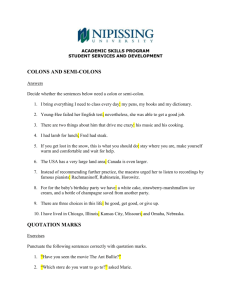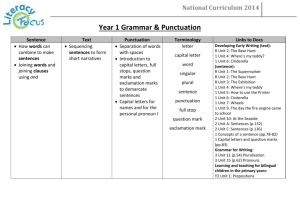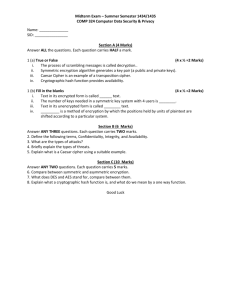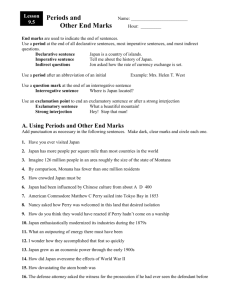answers - The Logic Manual
advertisement
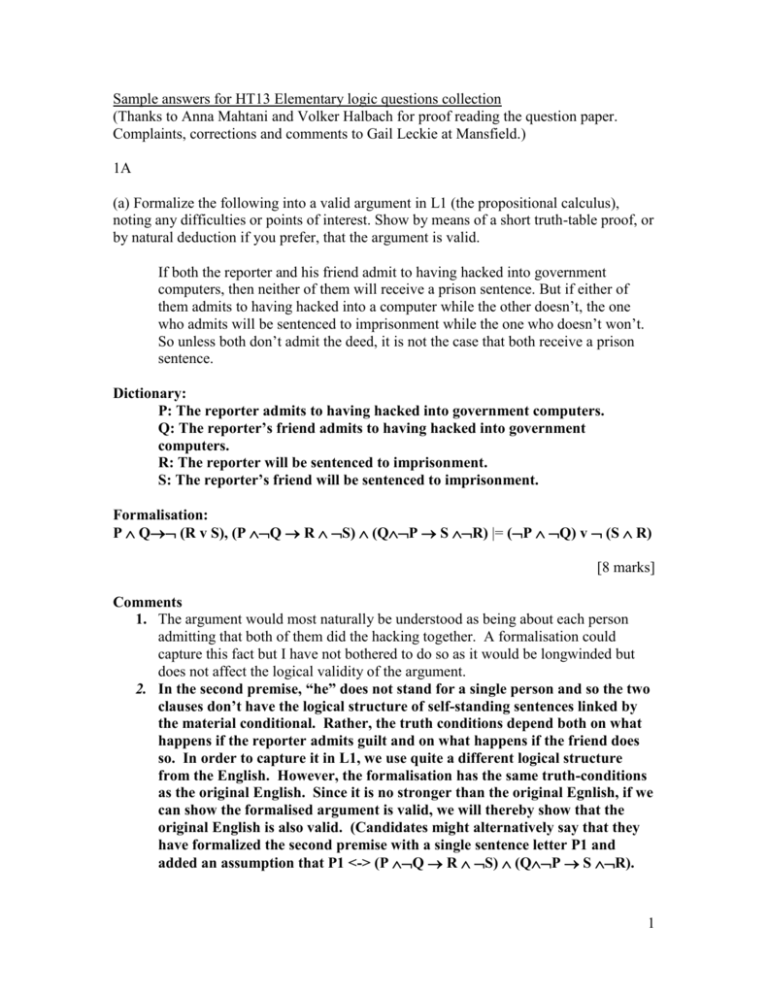
Sample answers for HT13 Elementary logic questions collection
(Thanks to Anna Mahtani and Volker Halbach for proof reading the question paper.
Complaints, corrections and comments to Gail Leckie at Mansfield.)
1A
(a) Formalize the following into a valid argument in L1 (the propositional calculus),
noting any difficulties or points of interest. Show by means of a short truth-table proof, or
by natural deduction if you prefer, that the argument is valid.
If both the reporter and his friend admit to having hacked into government
computers, then neither of them will receive a prison sentence. But if either of
them admits to having hacked into a computer while the other doesn’t, the one
who admits will be sentenced to imprisonment while the one who doesn’t won’t.
So unless both don’t admit the deed, it is not the case that both receive a prison
sentence.
Dictionary:
P: The reporter admits to having hacked into government computers.
Q: The reporter’s friend admits to having hacked into government
computers.
R: The reporter will be sentenced to imprisonment.
S: The reporter’s friend will be sentenced to imprisonment.
Formalisation:
P Q (R v S), (P Q R S) (QP S R) = (P Q) v (S R)
[8 marks]
Comments
1. The argument would most naturally be understood as being about each person
admitting that both of them did the hacking together. A formalisation could
capture this fact but I have not bothered to do so as it would be longwinded but
does not affect the logical validity of the argument.
2. In the second premise, “he” does not stand for a single person and so the two
clauses don’t have the logical structure of self-standing sentences linked by
the material conditional. Rather, the truth conditions depend both on what
happens if the reporter admits guilt and on what happens if the friend does
so. In order to capture it in L1, we use quite a different logical structure
from the English. However, the formalisation has the same truth-conditions
as the original English. Since it is no stronger than the original Egnlish, if we
can show the formalised argument is valid, we will thereby show that the
original English is also valid. (Candidates might alternatively say that they
have formalized the second premise with a single sentence letter P1 and
added an assumption that P1 <-> (P Q R S) (QP S R).
1
3. “P unless Q” is sometimes captured as an exclusive disjunction – i.e. P <->
¬Q – in formalisations. That is not appropriate here. Doing so will render
the argument invalid as P <-> ¬Q is stronger than P v Q. The English is
naturally read here as leaving what prison sentences are handed out should
neither admit hacking. The premises only support that conclusion. It would
be far too controversial assumption to take the speaker to be relying on that
if neither admits then no more than one will go to prison.
4. Candidates might also make comments about whether if…then is well formalised
by the arrow (thinking about causality, for example) which could receive some
credit.
[4 marks]
Partial Truth-table proof
P
^
Q
→ ¬
(R
v
S)
P1 P1 → ((P
^
¬
Q
→ R ^
1 T15 F14 F16 T F13 T10 T12 T11 T
T1 T
T17 T20 T19 F18 T3
2 F15 F14
T1 T
T3
T F13 T10 T12 T11 T
¬
S) ^
T21 T22 ?
T2
(Q
^
¬
P
→ S ^
¬
R)) (¬
T4
T2 T20 T23 T22 F21 T4
P
^
¬
Q)
F5
T24 T25 ?
v ¬( S
^
R)
F F6 T8 T7 T9
T17 F16 F5 F18 T19 F F6 T8 T7 T9
[4 marks]
(b)
i. What is a symmetric relation?
A relation is symmetric on a set S iff for all elements d, e of S: if <d,e> R then
<e,d> R.
A relation is symmetric iff it is symmetric on all sets.
ii. What is an asymmetric relation?
A relation is asymmetric on a set S iff for no elements d, e of S: both <d,e> R and
<e,d> R.
A relation is asymmetric iff it is asymmetric on all sets.
I’d let students who do not distinguish between (a)symmetry on a set and (a)symmetry
simpliciter but otherwise answer well may get full marks in this case since there are only
2 marks going.
Beware of students who talk about double arrows. Check their definition really is
equivalent (this may become clear in their answer to (c)). Being symmetric doesn’t
require that there are any double arrows. The empty relation is symmetric.
[2 marks]
(c) Is there a relation on the set of people which is:
i. symmetric but not reflexive on the set of all people?
Yes. e.g. {<x,y>: x is married to y}. (2 marks)
ii. asymmetric and reflexive on the set of all people
No because the set of people is not empty. It includes Fred so substitute Fred in for
e and d in the definition of asymmetry above to show that the relation cannot be
2
asymmetric. (1 mark for right answer. 1 for justification. I took off half for people
who talked as if reflexiveness was not relative to a set or who talked as if an asymmetric
relation can’t be reflexive on any set. It certainly is reflexive on the empty set. So it is
important that the student is aware that is significant that the set of all people is not
empty )
iii. neither symmetric nor asymmetric?
Yes. e.g. {<x,y>: x loves y} (1 mark for right answer. 1 for example that shows it.)
iv. symmetric and asymmetric?
Yes. the empty relation.
(2 marks for citing the empty domain. 1 mark available for someone with the wrong
answer but something approaching a sensible justification. Sometimes students get upset
about the existence of an empty relation, despite being fine with the existence of an empty
set. They just refuse to accept that it is a relation. It may help to give an intensional
example {<x,y> x is taller and shorter than y}. This is symmetric and asymmetric!
I’d give full marks in (c) for students who have confused asymmetry and antisymmetry in
(b) but applied their definitions consistently. They shouldn’t lose marks twice for a slip.
[7 marks]
1B
a) Use the following dictionary to translate each of the following sentences into L2:
P: … hacked into a government computer
Q: … received a prison sentence
R: …1 betrayed …2
P2:…is a person
There are prisoners who haven’t hacked government computers.
x(Qx Px P2x)
or x(Qx Px)
ii.
Anyone who hacked into a government computer got a prison sentence.
x(Px P2x Qx)
iii.
Those who’ve hacked into government computers didn’t betray anyone.
x(Px P2x y(P2y Rxy))
Or xy (Px P2x (P2y Rxy))
But not xy(Px P2x (P2y Rxy)) which says for each hacker,
there was someone they didn’t betray.
iv.
Whenever there was a betrayal, the betrayer was not imprisoned but the
person betrayed did to prison.
xy(Rxy P2x P2y Qx Qy)
or xy(Rxy P2y Qx Qy)
v.
Anyone who received a prison sentence must have been betrayed by someone.
x(Qx P2x y(P2y Ryx))
[10 marks]
I wouldn’t take off more than 1.5 marks if the candidate persistently failed to use P2.
i.
3
(b) What is it for a set of English sentences to be inconsistent?
A set of sentences is inconsistent iff there is no interpretation under which all of
them are true together.
(L1 is a formal language not English! I’m asking about consistency not validity so don’t
talk to me about arguments)
[1 mark]
(c) Is there an inconsistent set of English sentences:
i.
In which all the sentences are true?
No. By the definition, there is no interpretation on which they are all true so the
actual interpretation can’t be one on which they are all true.
ii.
Which can be made into a consistent set by adding a sentence?
No. If there is no interpretation on which they are all true, adding a sentence
won’t provide one. Adding a sentence can’t increase the range of interpretations
available.
iii.
Which can be made into a consistent set by removing just one sentence from
the set?
Yes. {Grass is not grass. Sky is blue} is inconsistent but {Sky is blue.} is
consistent.
Notice that {Grass is green. Grass is red.} is consistent by VH’s definition unless you
take colour words to be logical expressions. The sentences are all true on a
reinterpretation that takes “green” to mean living and “red” to mean edible by
sheep. See his comments about bachelors in chapter 1. Took off some but not all
marks for this mistake.
iv.
Which cannot be made into a consistent set by the removal of just one
sentence?
Yes. {Grass is not grass. The sky is not the sky}.
[9 marks]
(d)
i. Define semantic consistency for sentences of L1.
A set of L1-Sentences is semantically consistent iff there is an L1-Structure A such
that A=T for all sentences of .
ii. Define propositional consistency.
A set of English sentences is propositionally consistent iff the set of all their deepest
formalisations in propositional logic is semantically consistent.
[2 marks]
(e) Are there any sets of English sentences which are inconsistent but not propositionally
inconsistent? If so, give an example. If not, explain why not.
Yes. E.g. {Only one person rules. At least two people rule.}
[3 marks]
4


